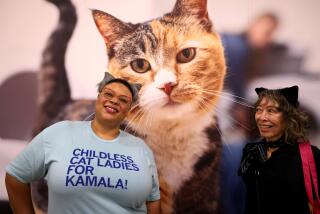COLUMN ONE : When Cat Fancy Goes Too Far : One woman had 200 felines; another wanted to renovate a guest house for hers. ‘Cat ladies’ see it as love, but experts say it’s an obsession that hurts both the owner and the animals.
The cats, all 200 of them, were Frances Palermo’s undoing.
By the time her bank and her neighbors evicted Palermo from her suburban New York condominium last year, the so-called Cat Lady of East Meadow’s inbred brood of orange-and-white cats had taken over the place, leaving a vile stench that wafted all the way to the parking lot.
Palermo’s unemployment checks went to her cats instead of her mortgage. But by the time authorities intervened, many of the animals were thin and ragged and had to be destroyed. Palermo, 63 at the time, was left destitute, an aging Lincoln Town Car her only possession.
So what is it with cat ladies?
Just the phrase conjures an image of a harmless eccentric or a filthy kook. But what transforms the average cat fancier into someone whose fondness for felines borders on obsession?
In the world of animal regulation, where “animal collectors” are a familiar part of the trade, theories abound.
Some experts say the infantile attributes of a cat’s face trigger the maternal instinct. Others contend that cats act rather like men--aloof, independent and stubborn--and, therefore, are attractive to women. Some cite a desire for control.
Whatever the case, studies show that women are indeed more likely than men to collect large numbers of animals. Cats are the animal of choice, although authorities have encountered dog ladies and recently even confiscated 38 pigs living inside a woman’s house in Lake View Terrace.
The vast majority of these women love and care for their cats and it has long been known that pets make people feel better. But mental health experts and humane advocates say extreme cases like Palermo’s exact a painful price on both the women and the cats they profess to love.
A Texas woman’s house was found to be littered with 21 dead cats and 23 sick ones, the floors and tables covered with feces, cat food and bugs. Recently, humane officers returned after two years to find four dead cats in her garage freezer.
A Washington state woman sheltered hundreds of unwanted cats in her small house until authorities confiscated the animals. “We found cats everywhere,” the local police chief told reporters. “We found cats in virtually every room, in every nook and cranny. We found cats in the kitchen. We found cats in the bathtub.”
And for 20 years, an Oakland woman loaded a pushcart and prowled the alleyways in search of hungry strays. The woman, who recently disappeared, spent every spare cent of her $938 monthly government income to feed the cats, sometimes going hungry herself.
“It’s a tragedy,” said Samantha Mullen of the Humane Society of the United States. “It’s very complex and people tend to oversimplify it. The tendency is to ascribe it to a love of animals gone awry, but it’s much more complex than that.”
Some compare the problem to the difference between a person who sips a glass of wine with dinner and an alcoholic who gets drunk before noon. As with alcoholism, the line between cat fancy and feline fetish can be vague.
“I call these guys cat-a-holics,” said Doris Romeo, a Beverly Hills caterer who runs a Van Nuys shelter for 400 unwanted and stray cats. Romeo, however, tries to place her cats in homes and emphatically distinguishes between what she does and the compulsion of collectors.
“Collecting is not about having a loving home,” Romeo said. “Collecting is not about love, it’s about control. I have real contempt for collectors.”
Romeo’s shelter, a converted house in an industrial neighborhood, depends entirely on donations. Although she is rarely very far from going broke, her shelter is spotless, the cats healthy, the litter boxes clean.
True animal collectors, on the other hand, often live in squalor. Many of the cats are underfed and sick, yet the women often refuse to acknowledge that their pets are anything but pictures of health.
A Newhall schoolteacher was hauled into court a few years ago after she refused to clean up her mobile home, which was littered with boxes, debris and waste from her dozen cats. The coach, she explained, was just disorganized.
“Many of these so-called animal lovers behave in ways that if they were a research facility they would have been shut down years ago,” said Alan Beck, a Purdue University professor of animal ecology. “I’m looking at a picture of a collector and the conditions in her house are so bad that if she was wearing a white lab coat at the UCLA Medical Center, people would want to kill her.”
Added Stephen Zawistowski, a psychologist for the American Society for the Prevention of Cruelty to Animals: “You end up going into these places with a space suit. There are feces on the floor and dead cats on bookshelves or behind chairs, kittens running in the walls.”
Very little academic study has been done on cat ladies, in part because they are so hard to find and because the subject, like the women themselves, is a bit eccentric.
But mental health and humane experts have identified a variety of mental illness models that fit obsessive cat ladies. Almost always, extreme cases are women who are socially isolated. Researchers have found few married cat ladies.
The New York State Humane Assn. has even compiled a list of characteristics animal collectors share. They include a clandestine lifestyle, a tendency to deny reality and sharp communication skills, which they often use to talk their way out of sticky situations.
For some, collection is an obsessive-compulsive disorder. In the same way that someone may irrationally save string or aluminum foil, cat ladies are compelled to hoard cats.
For others, the cats give a sense of power to the powerless. “For the most part these people are not in control and the cats are the only thing they have to control,” Beck said.
The cats remind almost all cat ladies of a period in their lives they look upon fondly. Collecting expert Ruth Smith said all collectors--from baseball card junkies to antique hounds--use their collections to remind them of a loved one or to connect with a happy experience.
Studio City resident Francine Katzenbogen, for instance, inherited cats from her brother and mother after they died. What she did next ruffled the fur of her neighbors. She proposed renovating a guest house to ensconce her 25 in luxury, complete with carpeted catwalks and skylights.
“If I went out and bought a piece of jewelry or expensive car, nobody would think twice or criticize me,” Katzenbogen told The Times in 1992. “If I want to spend my money and take care of my cats, which are my family, I don’t think it’s anybody’s business.”
Women such as Katzenbogen are worlds apart from women like Palermo, who ended up in a residential hotel and under a judge’s order not to keep any more than three cats. Then there are people such as Linda Nolan, a communications professor at the University of the Pacific in Stockton.
Nolan has 15 cats, but experts describe owners like her as true cat lovers--people who have more cats than might be considered normal, but who care for them properly.
“They are absolutely the most beautiful, loving creatures ever to grace this earth,” she said. “I get a satisfaction out of their needing me and they pay me back so richly.”
It’s that pay-back that leads from one cat to two cats and so on.
“It’s definitely like being a junkie,” said Annette Petelle, president of the Sun Valley-based Pet Rescue Assn. “You feel very powerful. This lifesaving thing is very gratifying. The other end of it is how do you take care of them once you’ve got them?”
Petelle almost fell into the trap of animal collecting, but as her menagerie of dogs, cats and other animals grew close to her current 150 she took a step back and saw where she was headed.
“I realized that I had to be able to feed what I take in,” she said. “At first, I thought I was going to go crazy because I felt so guilty, but in the long run sometimes you are better off letting them go.”
Now, her shelter accepts no new animals unless there is room.
For pathological cat collectors, Petelle’s realization comes too late or not at all. One characteristic almost all share is the feeling that their animals will be destroyed if they are discovered, that they are their cats’ only hope--what some psychologists call the “Jesus syndrome.”
“The nurturing thing has been turned on its side because it’s not really nurturing,” said John Wright, a psychology professor at Mercer University in Georgia. “In many cases, the animals are in such bad shape and they are not suitable for adoption so they have to be destroyed. The cat lady’s fears have come to pass.”
And once animal regulation officials do intervene, humane advocates said, courts rarely take the situation seriously. The judge in the Newhall case, for example, joked his way through the proceedings.
Few jurists follow the example of the judge in the Palermo case and order counseling or cap the number of animals collectors can have. In most cases, the cats are confiscated and the women are allowed to go free.
But once the eyes of short-staffed humane officials are diverted, the cycle frequently begins again. There are few reformed cat ladies.
For example, a Maryland woman had 50 pets confiscated a few years ago.
Two days later, she had 20 more.
More to Read
Sign up for Essential California
The most important California stories and recommendations in your inbox every morning.
You may occasionally receive promotional content from the Los Angeles Times.










